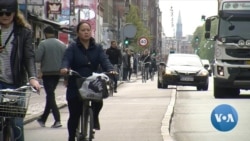For many, the term “ghetto” evokes the horrors of World War II and the Nazi persecution of the Jews. In Denmark, the government has adopted the terminology in a crackdown on migrant communities that many critics say is testing the basic tenets of equality under the law.
The right wing coalition government has identified 30 rundown districts across the country, which it has officially labeled “ghettoes.” All have high immigrant, Muslim populations. The policy has dismayed many liberal Danes and has stoked fierce debate as European citizens head to the polls in European Parliamentary elections this week.
At the top of the list is Mjolnerparken, a suburb in the Norrebro district of Copenhagen. It doesn’t look like a slum. Residents and visitors glide along the cycle lanes among well-kept apartment blocks, while kebab and baklava stores rub shoulders with the ubiquitous Danish bakeries.
WATCH: Denmark Targets Migrants in 'Ghetto' Crackdown
‘Danish values’ classes
But the Danish government has officially classified Mjolnerparken as a “ghetto,” with relatively high crime and unemployment and a large number of non-Western immigrants. It plans drastic action.
From the age of 1, ghetto children will be forced to spend at least 25 hours per week attending classes in “Danish values.” Criminals from the ghettoes can be given tougher sentences. Some public housing will be sold off and the residents evicted in an effort to break up immigrant communities.
The chairman of the Mjolnerparken residents association, Muhammad Aslam, moved to Denmark from Pakistan when he was 7. His parents answered a government call for migrants to come and work in Danish factories. Aslam is outraged by the government’s latest plans.
“In our family’s wildest imagination we couldn’t see that happening in this country, which almost all countries used to look up to. This is a very dangerous tendency as we saw in Europe in the 1930s in Germany, making the Jews scapegoats for everything. The same is about to happen now in Europe, just with another minority,” Aslam says.
Backed by the far right
The ghetto plan has the strong backing of the far right Danish People’s Party, which is not in the coalition government but supports much of its agenda and is widely seen as having dragged the centrist parties toward its position on immigration.
“Certain aspects of migrants coming here to the country have been overrepresented in crime statistics, underrepresented in employment statistics, overrepresented in welfare statistics. So for us there is a very good case both culturally and economically,” the Danish People’s Party member of European Parliament candidate Anders Vistisen told VOA in a recent interview.
His party is being outflanked by even more extreme right wing politicians. Rasmus Paludan, who has set up the tiny Stram Kurs Party, has gained notoriety for provocative stunts, such as entering Muslim areas and burning or desecrating the Quran, and posting the footage on YouTube. One such incident in April prompted riots in the capital.
Many Danes dismayed
The anti-migrant rhetoric has dismayed many Danes, like Karen Melchior from the Social Liberal Party.
“We need to stand firmly to our values and defend them, rather than caving in toward the fear of the unknown and of migration and of people from outside of your village or outside of your country,” Melchior told VOA.
The stereotype of a liberal, tolerant and welcoming Denmark is out of date, and many Danes support the ghetto plan, says political analyst Karina Kosiara-Pedersen of the University of Copenhagen.
“This is regarded as welfare. It’s regarded as supporting the children to be able to have a good life in Denmark. The attitudes of the Danes have changed in these last 25 years. And it is an issue that divides the Danish public,” she said.
Being tough on immigration is now often seen as vote winner in Denmark and increasingly across Europe. The results of the EU Parliament elections, due early next week, will show whether the public agrees.















